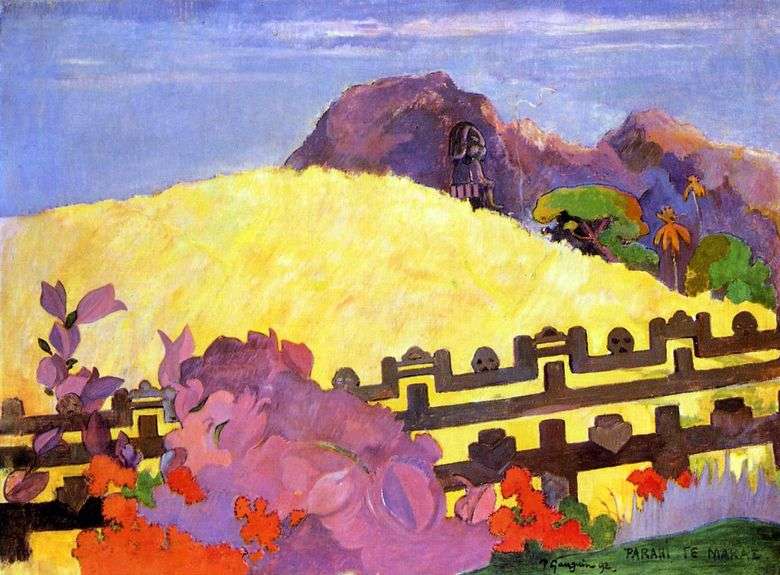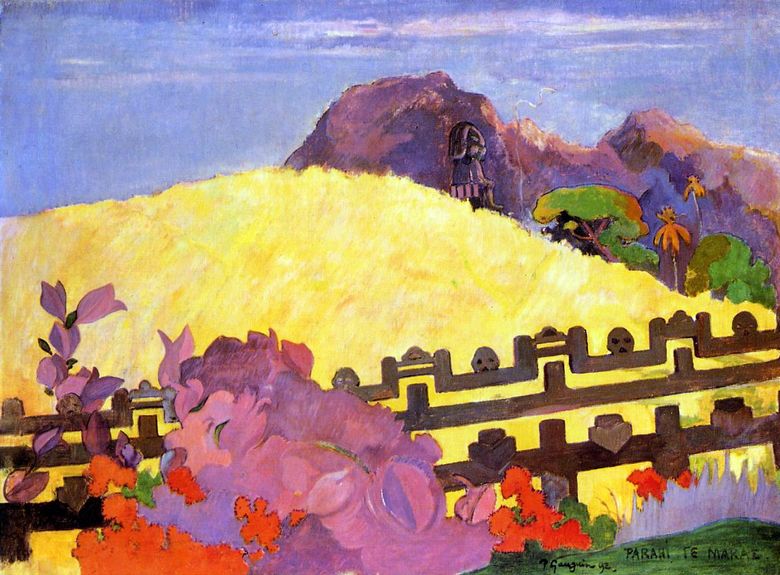
The presented canvas “Marae” belongs to one of the greatest Impressionists of its era, Paul Gauguin. The place of Marae, to which the painting is dedicated, in literal translation from the Polynesian language means “clean, weed-free place”. This is a sacred place of Polynesia pre-Christian times. His appointment was related to both public events and pagan rituals.
The cleared platform filled a large fenced space, in the center of which was the sacred stone ahu. Marae in French Polynesia was equipped with a stone in the form of a deity, an example of which was presented by Gauguin. His picturesque playground, as usual, is full of rainbow colors. This yellow-lemon field, which can be called “tasty.” Gauguin enclosed it with a wooden hedge with characteristic carvings for the Polynesian islands. Paul Gauguin wrote a quiet tranquility surrounded by lilac mountains. To balance the cold lilacs of the distant plan, the artist attributed exotic flowers to the fence.
A letter with color spots characteristically betrays the hand of the master, along with an unusual solution of individual elements. Pay attention to a bunch of gray grass near the red blooming flowers – a splotch of ridiculous shade in the patchwork of bright pieces. The lack of shadows in the Gaugens gave the landscape a planar character, but the rocky tops on the horizon came under shooting by the sun’s rays. These are yellow crowns with indecisive glare of light, they breathe nature and volume. Several bands of feather clouds also revitalized the sky.
The pinkish glow speaks of dawn, but the yellowness of the field is so bright and untouched by the crimson rays that it tears the canvas apart. I would like to work the canvas on the shadows, so that it would play with more vivid colors, but this is the whole of Gauguin. His fascination with Japanese graphics influenced his own technique of performance. This is indicated by the dense and smooth lines of plants, trees behind the field and, in fact, what was mentioned earlier, the rare presence of halftones. The work was written after the relocation of Paul Gauguin to Tahiti and became one of the many paintings of Tahitian author’s hot collection.
 Beautiful days by Paul Gauguin
Beautiful days by Paul Gauguin Marae – Paul Gauguin
Marae – Paul Gauguin Marae – Paul Gauguin
Marae – Paul Gauguin Self-Portrait with the Yellow Christ by Paul Gauguin
Self-Portrait with the Yellow Christ by Paul Gauguin Early evening by Paul Gauguin
Early evening by Paul Gauguin Still Life with Sunflowers on the Chair by Paul Gauguin
Still Life with Sunflowers on the Chair by Paul Gauguin Harvesting fruits by Paul Gauguin
Harvesting fruits by Paul Gauguin The King’s Wife by Paul Gauguin
The King’s Wife by Paul Gauguin